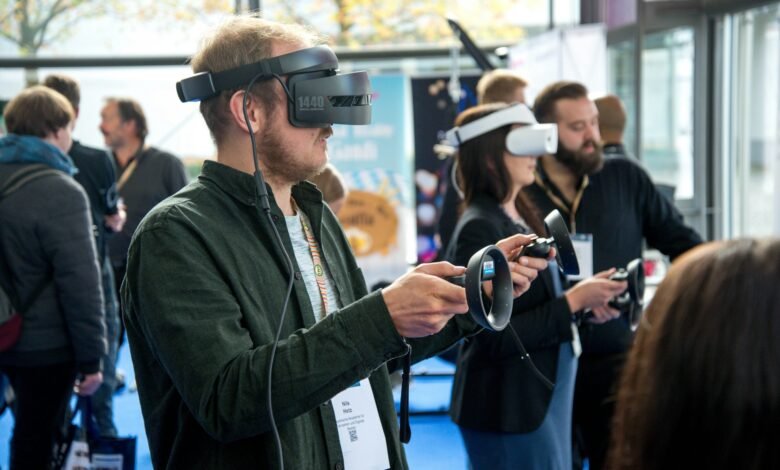How VR Training Is Reshaping the Industrial Landscape
Enhancing Industrial Skills Through VR Training

Introduction:
As industrial continually evolve amidst rapid technological advancements, traditional training methods are being reevaluated and often revamped. Virtual Reality (VR) has emerged as a cutting-edge tool in the training arsenal, offering profound enhancements in skill acquisition, safety training, and operational efficiency across various sectors, including MCC Motor Control Centers.
This blog explores how VR training is transforming the industrial sector by providing immersive, interactive learning experiences that are not only effective but also cost-efficient.
The Shift to VR Training: A Technological Leap in Industrial Skill Enhancement:
The industrial sector faces unique challenges that demand high precision, safety, and efficiency. Training in such environments typically requires extensive resources and can pose risks during the learning phase.
Virtual Reality introduces a game-changing solution by simulating real-world scenarios where employees can interact with virtual machinery and environments without the physical risks associated with traditional training methods.
Enhanced Engagement and Retention:
Learning through VR is not just a passive experience; it’s an engaging, hands-on practice that closely mimics real-world tasks. Studies have shown that VR training significantly enhances retention rates compared to conventional training methods.
By immersing trainees in lifelike scenarios, VR helps solidify learning through experience and repetition without the material wear and tear or the safety concerns of actual operation.
Safety During Training:
One of the paramount benefits of VR training in the industrial sector is the ability to simulate hazardous conditions without exposing trainees to real danger.
For industries like manufacturing, oil and gas, and construction, where safety is a major concern, VR provides a safe sandbox for learning and error. Trainees can learn to operate heavy machinery, manage hazardous materials, or navigate high-risk environments from the safety of a virtual space.
Customizable Learning Experiences:
Every industrial setting has its specificities, and VR platforms can be tailored to meet these diverse needs. Whether it’s learning the intricacies of a complex assembly line or mastering the control of gigantic cranes, VR training can be customized to replicate the exact conditions and challenges employees will face on the job.
This bespoke training approach helps in addressing the unique learning curves of different employees, enhancing overall competency in the workforce.
Real-World Applications and Case Studies:
Several leading companies in the industrial sector have already adopted VR training with significant success. For instance, a major automotive manufacturer has integrated VR to train assembly line workers, resulting in reduced training time and fewer assembly errors. Similarly, as part of a Software House project, another company has implemented VR to enhance its software development processes, further demonstrating the versatility of VR applications across different industry sectors.
Similarly, energy companies have employed VR to simulate emergency response situations for power plant operations, which has improved reaction times and preparedness among staff.
Advancements in VR Technology and Their Impact on Training:
As Virtual Reality technology continues to advance, its capabilities are becoming increasingly sophisticated, allowing for more complex and varied training scenarios to be created. These advancements are particularly beneficial in industries where precision and error management are crucial.
Interactive Learning and Problem-Solving:
VR training platforms are uniquely capable of teaching problem-solving skills in an interactive environment. Trainees are not just passive recipients of information but active participants who must navigate through tasks, solve problems, and make decisions that have immediate consequences within the virtual environment.
This active learning process is critical for developing practical skills that employees can transfer to real-world situations.
Scalability and Remote Training:
Another significant advantage of VR training is its scalability and flexibility. Companies can deploy VR training modules across multiple locations without the need for physical presence, which is particularly advantageous in today’s globalized industrial landscape.
Moreover, VR enables remote training, allowing employees to train from any location, reducing the need for travel and associated costs, and ensuring consistent training standards across geographically dispersed teams.
Metrics and Feedback:
VR systems track a user’s performance in real-time, providing immediate feedback invaluable for learning. This data-driven approach enables trainers to assess a trainee’s progress and proficiency in specific tasks, simplifying the identification of areas needing additional focus.
Collecting and analyzing such detailed performance data assists trainers in fine-tuning training programs to maximize their effectiveness and efficiency.
Integration with Other Technological Trends:
Combining VR with other emerging technologies such as augmented reality (AR) and mixed reality (MR) leads to even more comprehensive training solutions.
For instance, AR overlays additional information on top of the physical training modules, providing a hybrid approach that leverages both virtual and real-world elements.
This combination proves particularly effective in complex operational tasks that require a deep understanding of both theoretical and practical aspects.
Future Directions in VR Training:
Looking forward, the potential applications of VR in industrial training appear boundless. As VR technology incorporates more sensory feedback, like touch and smell, training experiences become even more immersive and realistic.
Furthermore, integrating artificial intelligence with VR can create adaptive learning environments that dynamically modify training scenarios based on the trainee’s performance, offering a truly customized learning experience.
Challenges and Considerations:
Despite its many benefits, integrating VR into industrial training programs presents challenges. Substantial initial setup and development costs occur, and adopting new technology often introduces a learning curve.
Moreover, the quality of the content and the realism of the simulation heavily influence the effectiveness of VR training. Maintaining and continuously updating the VR content is crucial to keep the training relevant and effective.
Conclusion:
The adoption of Virtual Reality training within the industrial sector, including in the Online Rental Business, marks a significant step towards modernizing and improving traditional training methodologies.
By providing safe, engaging, and effective training solutions, VR helps industries not only enhance the skills of their workforce but also improve their operational efficiency and safety standards.
As VR technology continues to evolve and become more accessible, its integration into industrial training regimes is likely to expand, setting a new standard in how skills are developed in high-risk environments.
Final Thoughts:
As industries increasingly recognize the value of innovative training solutions, Virtual Reality emerges as a particularly promising tool. It delivers a blend of safety, engagement, and efficiency that traditional methods struggle to match.
Companies seeking to stay competitive and prepare their workforce for the future are now viewing investment in VR training capabilities as essential, not just optional. This investment fosters a skilled, efficient, and safe working environment.




